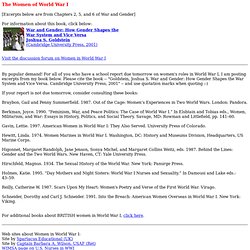

Feature Articles - Women and WWI - Women in the Workforce: Temporary Men. One immediate result of the war's outbreak was the rise in female unemployment, especially among the servants, whose jobs were lost to the middle-classes' wish to economise.

However, it was soon seen that the only option to replace the volunteers gone to the front was employing women in the jobs they had left behind; conscription only made this need even more urgent as had the Munitions of Work Act 1915 by which munitions factories had fallen under the sole control of the Government. As the main historian of women's work, Gail Braybon, claims, for many women the war was "a genuinely liberating experience" (link) that made them feel useful as citizens but that also gave them the freedom and the wages only men had enjoyed so far. Women's job mobility also increased enormously, with a large number of women abandoning service for factory work never to return to it to the chagrin of the middle-class women that were left without home help in many cases.
The Women of World War I. The Women of World War I [Excerpts below are from Chapters 2, 5, and 6 of War and Gender] For information about this book, click below: Visit the discussion forum on Women in World War I By popular demand!

For all of you who have a school report due tomorrow on women's roles in World War I, I am posting excerpts from my book below. If your report is not due tomorrow, consider consulting these books: Braybon, Gail and Penny Summerfield. 1987. Berkman, Joyce. 1990. Gavin, Lettie. 1997. Hewitt, Linda. 1974. Higonnet, Margaret Randolph, Jane Jenson, Sonya Michel, and Margaret Collins Weitz, eds. 1987. Hirschfeld, Magnus. 1934. Holmes, Katie. 1995. Reilly, Catherine W. 1987. Schneider, Dorothy and Carl J. For additional books about BRITISH women in World War I, click here.
Web sites about Women in World War I: Site by Spartacus Educational (UK) Site by Captain Barbara A. Excerpts from Chapters 2, 5, and 6 of Joshua S. The World Wars shook up gender relations, but only temporarily. Women In World War 1. How did women contribute to the war effort in ww1. As well as holding together their families and communities, they had to fill the jobs the men had left.

(Quote from spartacus.schoolnet.com) - Women filled many jobs brought into existence by wartime needs. As a result the number of women employed increased from 3,224,600 in July, 1914 to 4,814,600 in January 1918. Nearly 200,000 women were employed in government departments. Half a million became clerical workers in private offices. They also joined agencies such as the V.A.D - voluntary aid detatchment, and served as nurses, drivers, and letter writers for men too ill to write for themselves. "I wanted to do my bit for the war so I volunteered to drive an ambulance. Members of suffragette campaign groups such as the NUWSS called off their campaigns in order to focus on the war effort. Slang of the 1920. World War One, The Great War.